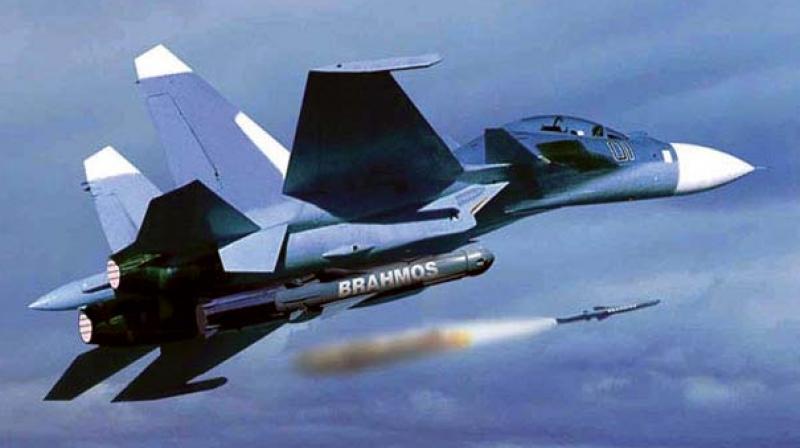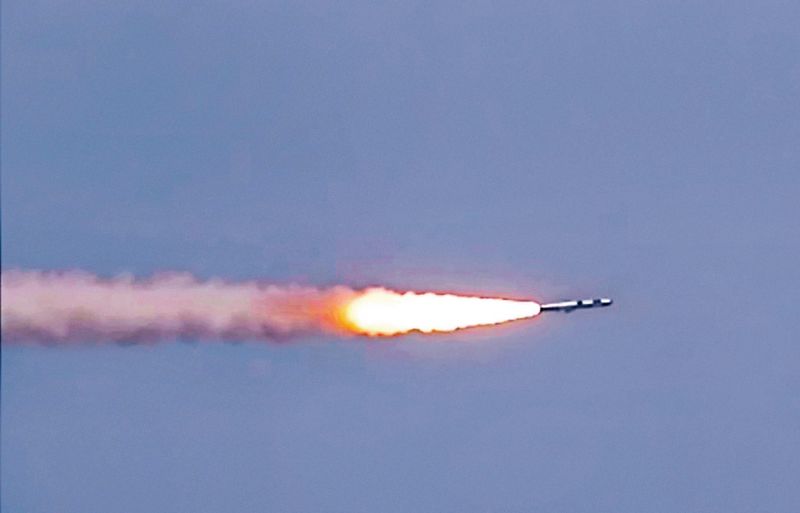Giant leap: Air-launched BrahMos supersonic cruise missile successfully tested
Two units of the IAF in Bengaluru played a critical role in Wednesday's successful launch of BrahMos missile.

Bengaluru: Two back-to-back feats: Wednesday's test firing of BrahMos supersonic cruise missile by a Sukhoi-30MKI fighter jet and successful launch of 'Nirbhay' cruise missile a fortnight ago not only signify the country's superiority in the region but also open up new opportunities to enhance the capability of the armed forces to carry out deep surgical strikes on strategic targets across the borders.
The lethal combination of a fighter aircraft such as the Su-30MKI, with a cruising range of 3,200 km and BrahMos missile, which rockets three times the speed of sound, could decimate targets located 270-290 km away on the ground or in the sea, thus proving an important arrow in the Indian Air Force (IAF)'s Quiver. More important, according to former IAF Chief Air Chief Marshal Srinivasapuram Krishnaswamy (Retd), it not only opens a new chapter in air superiority, but opens opportunities for development of several variants of BrahMos to arm other fighter jets such as the Rafale and the Advanced Medium Combat Aircraft.
“I am very proud of the Indian effort as this combination (Su-30+BrahMos) can take on targets from long distance at high speeds, leaving the enemy defenceless. Let’s stop criticising DRDO, and cheer them for today’s achievement as it is not the end but opens up opportunities for development of new missiles. Let’s also say kudos to the IAF and Hindustan Aeronautics Ltd (HAL) for today’s success,” he told Deccan Chronicle.
 A video grab shows the BrahMos supersonic cruise missile, that was fired succesfully for the first time from a Sukhoi-30MKI fighter jet of the IAF over the Bay of Bengal. The missile was gravity dropped from the Su-30MKI from its fuselage, and the two-stage missile’s engine fired up and was propelled towards the intended target in the Bay of Bengal. (Photo: PTI)
A video grab shows the BrahMos supersonic cruise missile, that was fired succesfully for the first time from a Sukhoi-30MKI fighter jet of the IAF over the Bay of Bengal. The missile was gravity dropped from the Su-30MKI from its fuselage, and the two-stage missile’s engine fired up and was propelled towards the intended target in the Bay of Bengal. (Photo: PTI)
Dr S. Christopher, DRDO chairman, remarked: “It’s another great day for DRDO. It is one of our major achievements leading to a unique weapon delivery from a fighter aircraft which even the Russians have not achieved with their own Su-30s.”
Wednesday’s mission witnessed the BrahMos equipped Su-30 fighter jet taking off from Kalaikunda air force station, cruise over the Bay of Bengal before releasing the missile to decimate a target, an old ship provided by the Indian Navy, about 290 km away.
While various units of DRDO developed the navigation, terminal guidance and other systems for the missile, HAL’s unit at Nashik modified the Su-30 to strengthen the fuselage, the belly station to hug the 2,500 kg missile, and a special ejection mechanism to ensure a free fall of 60-100 meters of the missile before speeding towards the target in the sea.
In a statement issued after the test-firing, the IAF said, “The launch from the aircraft was smooth and the missile followed the desired trajectory before directly hitting the ship target.” “The capability of the missile coupled with the superlative performance of the Su-30 aircraft gives the IAF a strategic reach and allows it to dominate the ocean and battle fields,” the statement added.
Official sources said 42 of the 240 Su-30 fighter jets would be modified to carry out deep surgical strikes simultaneously with more test-firing of BrahMos by these aircraft.
The IAF said it became the first air force in the world to successfully launch a surface attack missile of this category and that the weapon provided it a much desired capability to strike from large stand-off ranges on any target in sea or land with “pinpoint accuracy” in all weather conditions.
The successful test firing of the 2.5 ton missile, which flies almost three times the speed of sound at Mach 2.8 and has a range of 290 km, paved the way for its induction into the IAF.
The range of the missile, an Indo-Russia joint venture, can be extended up to 400 km as technical restrictions were lifted after India became a full member of the Missile Technology Control Regime (MTCR) last year.

